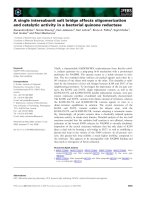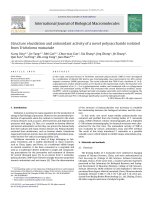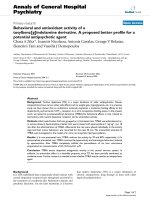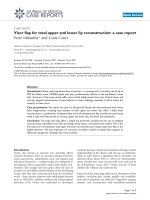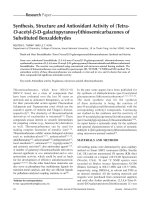determination of total phenolic and flavonoid content antimicrobial and antioxidant activity of a root extract of arisaema jacquemontii blume
Bạn đang xem bản rút gọn của tài liệu. Xem và tải ngay bản đầy đủ của tài liệu tại đây (599.24 KB, 6 trang )
+Model
JTUSCI-111; No. of Pages 6
ARTICLE IN PRESS
Available online at www.sciencedirect.com
ScienceDirect
Journal of Taibah University for Science xxx (2015) xxx–xxx
Determination of total phenolic and flavonoid content, antimicrobial
and antioxidant activity of a root extract of Arisaema jacquemontii
Blume
Shoib A. Baba a,∗ , Shahid A. Malik b
a
b
Department of Botany, University of Kashmir, Srinagar 190001, Jammu and Kashmir, India
Department of Chemistry, University of Kashmir, Srinagar 190001, Jammu and Kashmir, India
Received 26 June 2014; received in revised form 25 October 2014; accepted 5 November 2014
Abstract
We evaluated the antioxidant and antimicrobial activity of a methanolic extract of the roots of Arisaema jacquemontii. Antioxidant
activity was determined in the 1,1-diphenyl-2-picryl-hydrazyl (DPPH), nitroblue tetrazolium (NBT) and ferric reducing power tests.
The extract had significant antioxidant activity in all assays, with values of 64.16 ± 0.19% in the DPPH and 62.16 ± 0.17% in the
NBT assays, and reduced Fe3+ ferricyanide complex to the ferrous form (Fe2+ ). Antibacterial activity and minimum inhibitory
concentrations were calculated by the broth dilution method. The root extract prevented the growth of both Gram-positive and
Gram-negative bacteria, at a minimum inhibitory concentration of 0.24–0.41 mg/mL. Antifungal activity, measured as inhibition of
mycelium growth, was 28.32–36.50%. The antimicrobial and antioxidant activities of the extracts were positively associated with
the total phenolic and flavonoid contents of the extract.
© 2014 The Authors. Production and hosting by Elsevier B.V. This is an open access article under the CC BY-NC-ND license
( />Keywords: Arisaema jacquemontii; Antioxidant; Antifungal; Antibacterial
1. Introduction
Changing environmental conditions are giving rise
to a variety of free radicals, which plants have to
deal with them in order to survive. Reactive oxygen
species, such as singlet oxygen, superoxide ion, hydroxyl
∗
Corresponding author. Tel.: +91 9797757900.
E-mail address: (S.A. Baba).
Peer review under responsibility of Taibah University.
ion and hydrogen peroxide, are highly reactive, toxic
molecules, which are generated normally in cells during
metabolism. They cause severe oxidative damage to proteins, lipids, enzymes and DNA by covalent binding and
lipid peroxidation, with subsequent tissue injury. Natural
antioxidant agents have attracted much interest because
of their ability to scavenge free radicals [1]. Free radicals
have been implicated in the development of a number
of disorders, including cancer, neurodegeneration and
inflammation [2–4], giving rise to studies of antioxidants for the prevention and treatment of diseases. The
presence of antioxidants such as phenolics, flavonoids,
tannins and proanthocyanidins in plants may provide
protection against a number of diseases; for example,
ingestion of natural antioxidants has been inversely
/>1658-3655 © 2014 The Authors. Production and hosting by Elsevier B.V. This is an open access article under the CC BY-NC-ND license
( />
Please cite this article in press as: S.A. Baba, S.A. Malik. Determination of total phenolic and flavonoid content,
antimicrobial and antioxidant activity of a root extract of Arisaema jacquemontii Blume, J. Taibah Univ. Sci. (2015),
/>
+Model
JTUSCI-111; No. of Pages 6
2
ARTICLE IN PRESS
S.A. Baba, S.A. Malik / Journal of Taibah University for Science xxx (2015) xxx–xxx
associated with morbidity and mortality from degenerative disorders [5]. Medicinal plants are therefore being
investigated for their antioxidant properties, and the
demand for natural antioxidants and food preservatives
is increasing [6].
Arisaema jacquemontii is an important medicinal
plant of Kashmir, which has been used to cure various ailments in traditional systems of medicine. The
plant belongs to the family Araceae and is commonly
known as cobra lily. It is used as a food, an anthelmenthic and in the treatment of respiratory infections,
dermatitis and as an antidote for snakebites [7]. A
lectin from A. jacquemontii tuber was reported to have
anti-insect and anti-proliferative properties [8]. Anticonvulsant activity and an effect on platelet aggregation
have also been reported [9], and the leaves have been
reported to have antioxidant and immunomodulating
potential [10]. Although the plant is widely used in traditional medicine, few studies have been conducted of
the pharmacological activities of the plant. Phenolic and
flavonoid compounds are widespread in plant kingdom
where they act as antioxidants and free radical scavengers. The objective of this study was to determine the
total phenolic and flavonoid content and the antioxidant
and antimicrobial activity of a methanolic extract of roots
of A. jacquemontii.
2. Materials and methods
2.1. Plant material and preparation of extract
Roots of A. jacquemontii were collected in Uri,
Jammu and Kashmir. The identity of plant was confirmed
at the Centre of Plant Taxonomy and Biodiversity, University of Kashmir. The roots were dried in shade at room
temperature, then chopped and ground to a fine powder in a mechanical blender. Dried root powder (20 g)
was packed into a Soxhlet apparatus and extracted with
300 mL methanol at 60–65 ◦ C for 3–4 h. The extract was
filtered through Whatman filter paper No. 1, and the filtrate was concentrated under reduced pressure at 40 ◦ C.
The extract was dried, weighed (2.6 g) and stored at 4 ◦ C
in storage vials for experimental use.
2.2. Total phenolic content
The total phenolic content of the extract was determined by the Folin–Ciocalteu method [11]. Briefly,
200 L of crude extract (1 mg/mL) were made up to
3 mL with distilled water, mixed thoroughly with 0.5 mL
of Folin–Ciocalteu reagent for 3 min, followed by the
addition of 2 mL of 20% (w/v) sodium carbonate. The
mixture was allowed to stand for a further 60 min in
the dark, and absorbance was measured at 650 nm. The
total phenolic content was calculated from the calibration
curve, and the results were expressed as mg of gallic acid
equivalent per g dry weight.
2.3. Total flavonoid content
The total flavonoid content of crude extract was determined by the aluminium chloride colorimetric method
[12]. In brief, 50 L of crude extract (1 mg/mL ethanol)
were made up to 1 mL with methanol, mixed with 4 mL
of distilled water and then 0.3 mL of 5% NaNO2 solution; 0.3 mL of 10% AlCl3 solution was added after
5 min of incubation, and the mixture was allowed to
stand for 6 min. Then, 2 mL of 1 mol/L NaOH solution
were added, and the final volume of the mixture was
brought to 10 mL with double-distilled water. The mixture was allowed to stand for 15 min, and absorbance
was measured at 510 nm. The total flavonoid content was
calculated from a calibration curve, and the result was
expressed as mg rutin equivalent per g dry weight.
2.4. Antioxidant properties
2.4.1. 1,1-Diphenyl-2-picryl-hydrazyl assay
The antioxidant activity of the extract was determined
by the 1,1-diphenyl-2-picryl-hydrazyl (DPPH) assay, as
described earlier with some modifications [13]. Briefly,
200 L of each extract (100–500 g/mL) were mixed
with 3.8 mL DPPH solution and incubated in the dark at
room temperature for 1 h. The absorbance of the mixture
was then measured at 517 nm. Ascorbic acid was used as
a positive control. The ability of the sample to scavenge
DPPH radical was determined from:
DPPH scavenging effect =
Control OD − Sample OD
× 100
Control OD
2.4.2. Nitroblue tetrazolium assay
Superoxide anion scavenging activity was determined as described earlier [14]. The reaction was
performed in 50 mmol/L phosphate buffer (pH 7.8) containing concentrations of 100–500 g/mL of the extract,
1.5 mmol/L riboflavin, 50 mmol/L nitroblue tetrazolium
(NBT), 10 mmol/L d,l-methionine, and 0.025% (v/v)
Triton X-100. The reaction was initiated by illuminating the reaction mixture; the absorbance of formazan
was recorded at 560 nm, and the percentage scavenging
activity was described as the inverse of the produced
formazan. Ascorbic acid was used as a positive control.
Please cite this article in press as: S.A. Baba, S.A. Malik. Determination of total phenolic and flavonoid content,
antimicrobial and antioxidant activity of a root extract of Arisaema jacquemontii Blume, J. Taibah Univ. Sci. (2015),
/>
+Model
JTUSCI-111; No. of Pages 6
ARTICLE IN PRESS
S.A. Baba, S.A. Malik / Journal of Taibah University for Science xxx (2015) xxx–xxx
Table 1
Total phenolics and flavonoids content of methanolic extract of A.
jacquemontii roots.
Total phenolics contenta
Total flavonoids contentb
45 ± 1.7
35.5 ± 2.2
a
mg gallic acid equivalent (GAE)/g DW.
mg rutin equivalent/g DW.
Values are means of three biological replicates.
3
disc of Whatman paper No. 3 was soaked with 20 L of
root extract, allowed to dry and placed on the inoculated
Petri dishes. For the control, the disc was moistened with
methanol. The plates were then incubated at 28 ◦ C for 7
days. Antifungal activity was evaluated as the percentage
inhibition of mycelium growth according to the formula:
b
%I =
2.4.3. Ferric reducing power assay
Ferric reducing or antioxidant power was determined as described earlier [15]. Briefly, 100 L of the
extract (100–500 g/mL) were mixed with 2.5 mL of
200 mmol/L phosphate buffer (pH 6.6) and 2.5 mL of
1% potassium ferricyanide and incubated at 50 ◦ C for
20 min. Then, 2.5 mL of 10% trichloroacetic acid were
added, and the tubes were centrifuged at 10,000 rpm for
10 min. Then, 5 mL of the upper layer were mixed with
5.0 mL distilled water and 1 mL of 0.1% ferric chloride,
and the absorbance of the reaction mixtures was measured at 700 nm. Ascorbic acid was used as a positive
control.
C−T
× 100
C
where C and T are the mean mycelium growth (mm) of
controls and treated discs. All tests were performed in
triplicate.
2.6. Statistical analysis
Statistical analysis was carried out with GraphPad
Prism 6 software (Graph Pad Software, Inc., USA), and
results are expressed as means ± standard deviation.
3. Results and discussion
3.1. Phenolic and flavonoid contents
2.5. Antimicrobial property
The total phenolic content of the methanolic
root extract, calculated from the calibration curve
(R2 = 0.998), was 45.17 ± 1.70 gallic acid equivalents/g, and the total flavonoid content (R2 = 0.999) was
35 ± 2.20 rutin equivalents/g (Table 1). Phenolic compounds have redox properties, which allow them to act as
antioxidants [20]. As their free radical scavenging ability
is facilitated by their hydroxyl groups, the total phenolic
concentration could be used as a basis for rapid screening
of antioxidant activity. Flavonoids, including flavones,
flavanols and condensed tannins, are plant secondary
metabolites, the antioxidant activity of which depends
on the presence of free OH groups, especially 3-OH.
Plant flavonoids have antioxidant activity in vitro and
also act as antioxidants in vivo [21,22]. As this is the
first report on the antioxidant activity of A. jacquemontii, thorough phytochemical analyses should be done to
identify the active phenolic and flavonoid components.
2.5.1. Antibacterial activity
Antimicrobial activity was tested in both Gramnegative and Gram-positive bacteria obtained from the
Department of Microbiology, RTM Nagpur University,
Nagpur, India. The strains were maintained by periodic
subculture on nutrient agar and preserved at 4 ◦ C prior
to use. They were grown overnight in 10 mL broth at
37 ◦ C, which was then centrifuged at 150 rpm. Minimum inhibitory concentrations (MICs) were determined
by the broth microdilution method [16–18]. Serial dilutions of the stock solutions of the crude extract in
broth medium were prepared on a microtitre plate, and
microbial suspensions were added to the microwells at
5 × 105 microorganisms/mL. The microtitre plates were
then incubated at 37 ◦ C for 24 h. Activity was recorded as
blue colouration in the wells after addition of resazurin.
MICs were determined as the lowest concentrations that
prevented visible growth. Streptomycin was used as a
positive control. Each assay was repeated three times.
3.2. Antioxidant activity
2.5.2. Antifungal activity
The antifungal activity of the root extract of A. jacquemontii was determined by the disc diffusion method
[19]. A conidial suspension (1 mL) of each fungus was
added to each Petri dish, followed by 15 mL of potato
dextrose agar supplemented with streptomycin sulfate
(100 mg/L). After solidification of the substrate, a 5-mm
Plants rich in secondary metabolites, including
phenolics, flavonoids and carotenoids, have antioxidant
activity due to their redox properties and chemical structures. The methanolic root extract of A. jacquemontii had
strong antioxidant activity against all the free radicals
investigated. The DPPH radical is widely used in assessing free radical scavenging activity because of the ease
Please cite this article in press as: S.A. Baba, S.A. Malik. Determination of total phenolic and flavonoid content,
antimicrobial and antioxidant activity of a root extract of Arisaema jacquemontii Blume, J. Taibah Univ. Sci. (2015),
/>
+Model
JTUSCI-111; No. of Pages 6
4
ARTICLE IN PRESS
90
80
70
60
50
40
30
20
10
0
Root extract
Ascorbic acid
0
(a)
200
400
Conentration(µg/ml)
600
% Inhibition
% inhibition
S.A. Baba, S.A. Malik / Journal of Taibah University for Science xxx (2015) xxx–xxx
100
90
80
70
60
50
40
30
20
10
0
Root Extract
Ascorbic Acid
0
200
400
Concentration (µg/ml)
(b)
600
3
Absorbance
2.5
2
Root extract
1.5
Ascorbic Acid
1
0.5
0
100
(c)
200
300
400
Concentration(µg/ml)
500
Fig. 1. (a) Free radical scavenging activity, (b) superoxide scavenging activity, (c) ferrous reducing capacity of methanolic extracts of the roots of
Arisaema jacquemontii. Ascorbic acid was included as a positive control. Each value is the mean ± standard deviation.
of the reaction. DPPH scavenging activity was 64.16%
at a concentration of 500 g/mL root extract, while that
of the control, ascorbic acid, was 84% (Fig. 1). Superoxide is a reactive oxygen species that can damage cells
and DNA, leading to various diseases [23]. Superoxide
scavenging activity, determined in the NBT assay, was
62.16% for 500 g/mL of the root extract and 89.36%
for ascorbic acid (Fig. 1). In assays of the reducing power
of the crude extract, significant changes in absorbance
at 700 nm were observed (0.12–0.64) with increasing
concentrations of extract (100–500 g/mL) (Fig. 1).
The high phenolic and flavonoid content is responsible for the bioactivity of these crude extracts.
Flavonoids are highly effective scavengers of most
oxidizing molecules, including singlet oxygen, and various other free radicals implicated in several diseases
[24]. Flavonoids suppress reactive oxygen formation,
chelate trace elements involved in free-radical production, scavenge reactive species and up-regulate and
protect antioxidant defenses [25]. Similarly, phenolics
conferring oxidative stress tolerance on plants. Crude
extracts of fruits, herbs, vegetables, cereals and other
plant materials rich in phenolics are increasingly being
used in the food industry for their antioxidative properties and health benefits.
Table 2a
Antibacterial activity of methanolic extract of A. jacquemontii of roots
(MIC values expressed as mg/ml).
Microorganism
Root extract
Proteus mirabilis
Streptococcus faecalis
Escherichia coli
Salmonella enteritidis
Micrococcus luteus
Enterobacter cloacae
Bacillus subtilis
Staphylococcus aureus
Pasturella multocida
0.29
0.41
0.34
0.24
0.27
0.35
0.28
0.37
0.32
±
±
±
±
±
±
±
±
±
0.015
0.012
0.012
0.014
0.008
0.015
0.008
0.012
0.014
Streptomycin
0.056
0.025
0.055
0.020
0.020
0.015
0.025
0.025
0.020
±
±
±
±
±
±
±
±
±
0.003
0.002
0.004
0.002
0.003
0.004
0.003
0.003
0.003
3.3. Antimicrobial activity
The antibacterial properties of methanolic extract of
the roots of A. jacquemontii in vitro are presented in
Table 2. The extracts had antibacterial activity against
both Gram-positive and Gram-negative bacteria, with
MICs of 0.24–0.41 mg/mL. The extract had the greatest
activity against Salmonella enteritidis and Micrococcus luteus and the least against Streptococcus faecalis
and Staphylococcus aureus. The root extract also had
significant antifungal activity (Table 2), with values of
Please cite this article in press as: S.A. Baba, S.A. Malik. Determination of total phenolic and flavonoid content,
antimicrobial and antioxidant activity of a root extract of Arisaema jacquemontii Blume, J. Taibah Univ. Sci. (2015),
/>
+Model
JTUSCI-111; No. of Pages 6
ARTICLE IN PRESS
S.A. Baba, S.A. Malik / Journal of Taibah University for Science xxx (2015) xxx–xxx
Table 2b
Antifungal activity of methanolic extract of A. jacquemontii roots
(expressed as % inhibition of mycelium growth).
Sample
Fusarium
oxysporum
Root
36.50
extract
Benomyl 71.14
[2]
Phythium
ultimum
Rhizoctonia
solani
Aspergillus
flavus
[3]
29.00
34.00
28.32
[4]
75.50
87.00
69.00
[5]
Each value is a mean of three biological replicates.
28.32–36.50%, the greatest activity being seen against
Fusarium oxysporum and the least against Aspergillus
flavus.
These results suggest that A. jacquemontii is a potential source of broad-spectrum antimicrobial agents. The
antimicrobial activity of the extract may be attributed to
the high content of flavonoids, which have been reported
to be involved in inhibition of nucleic acid biosynthesis and other metabolic processes [26]. Flavonoids have
also been reported to inhibit spore germination of plant
pathogens [27]. Moreover, flavonoids are synthesized by
plants in response to microbial infection. Phenolic compounds with a C3 side chain at a lower level of oxidation
and containing no oxygen have often been reported to be
antimicrobials [28]. The partially hydrophobic nature of
their phenolic compounds has also been reported to be
responsible for their antimicrobial activity. The mechanism of the toxicity of polyphenols against microbes may
be related to inhibition of hydrolytic enzymes (proteases)
or other interactions that inactivate microbial adhesins,
cell envelope transport proteins and non-specific interactions with carbohydrates [29]. The antifungal and
antimicrobial activity of phenolic and flavonoid compounds has been reported previously [30–32]. Isolation
of the responsible elements is necessary for fully elucidating the antibacterial activity of these crude extracts.
This might also provide insight about their possible use
in food and non-food systems.
[6]
[7]
[8]
[9]
[10]
[11]
[12]
[13]
[14]
[15]
[16]
4. Conclusion
Our results suggest that A. jacquemontii is a potential
source of antioxidant and antimicrobial agents and could
be used as a natural antioxidant and preservative in food
and non-food systems. Further phtyochemical analysis
is required to isolate the elements of the plant that show
a broad spectrum of pharmacological activity.
References
[1] N. Saeed, M.R. Khan, M. Shabbir, Antioxidant activity, total
phenolic and total flavonoid contents of whole plant extracts
[17]
[18]
[19]
[20]
5
Torilis leptophylla L., BMC Complement. Altern. Med. 12 (2012)
221.
B. Halliwell, Oxidative stress and cancer: have we moved forward? Biochem. J. 401 (2007) 1–11.
B. Halliwell, Oxidative stress and neurodegeneration: where are
we now? J. Neurochem. 97 (2006) 1634–1658.
L.R. Ferguson, Chronic inflammation and mutagenesis, Mutat.
Res. Fund. Mol. 690 (2010) 3–11.
I. Gulcin, Antioxidant activity of food constituents: an overview,
Arch. Toxicol. 86 (2012) 345–391.
W. Peschel, F. Sanchez-Rabaneda, W. Dieckmann, A. Plescher,
I. Gartzia, et al., An industrial approach in the search of natural
antioxidants from vegetable and fruits wastes, Food Chem. 97
(2006) 137–150.
H. Verma, V.K. Lal, K.K. Pant, N. Soni, A review on Arisaema
jacquemontii, J. Pharm. Res. 5 (2012) 1480–1482.
M. Kaur, K. Singh, J.P. Rup, S.S. Kamboj, A.K. Saxena,
M. Sharma, M. Bhagat, S.K. Sood, J. Singh, A tuber lectin
from Arisaema jacquemontii Blume with anti-insect and antiproliferative properties, J. Biochem. Mol. Biol. 39 (2006)
432–440.
S. Jeelani, M.A. Khuroo, T.K. Razadan, New triterpenoids
from Arisaema jacquemontii, J. Asian Nat. Prod. Res. 2 (2010)
157–161.
R.R. Sudan, M. Bhagat, S. Gupta, J. Singh, A. Koul, Iron (FEII)
chealtion, ferric reducing antioxidant power, and immune modulating potential of Arisaema jacquemontii (Himalayan cobra lily),
Biomed. Res. Int. 2014 (2014) 179865.
C. Kaur, H.C. Kapoor, Anti-oxidant activity and total phenolic
content of some Asian vegetables, Int. J. Food Sci. Technol. 37
(2002) 153–161.
C. Chang, M. Yang, H. Wen, J. Chern, Estimation of total
flavonoid content in propolis by two complementary colorimetric
methods, J. Food Drug Anal. 10 (2002) 178–182.
D. Villano, M.S. Fernandez-Pachon, M.L. Moya, A.M. Troncoso,
M.C. Garcıa-Parrilla, Radical scavenging ability of polyphenolic compounds towards DPPH free radical, Talanta 71 (2007)
230.
D. Vyas, S. Kumar, Purification and partial characterization of a
low temperature responsive Mn-SOD from tea (Camellia sinensis
(L.) O. Kuntze), Biochem. Biophys. Res. Commun. 329 (2005)
831–838.
H. Zhao, W. Fan, J. Dong, J. Lu, J. Chen, et al., Evaluation
of antioxidant activities and total phenolic contents of typical
malting barley varieties, Food Chem. 107 (2008) 296–304.
M.J. Salvador, E.O. Ferreira, E.M.F. Pral, S.C. Alfieri, S. Albuquerque, I.Y. Ito, et al., Bioactivity of crude extracts and some
constituents of Blutaparon portulacoides (Amaranthaceae), Phytomedicine 9 (2002) 566–571.
H.M. Ericcson, J.C. Sherris, Antibiotic sensitivity testing: report
of an international collaborative study, Acta Pathol. Microbiol.
Scand. 217 (1971) 1.
W.C. Evans, Trease and Evans’ Pharmacognosy, 14th ed., W.B.
Saunders Co. Ltd., Singapore, 1996, pp. 290.
B. Naima, N. Débbabi, H.B. Jannet, Z. Mighri, M.E. Mahjoub,
Antifungal activity of volatile components extracted from leaves,
stems and flowers of four plants growing in Tunisia, Phytopathol.
Mediterr. 44 (2005) 307–312.
M.A. Soobrattee, V.S. Neergheen, A. Luximon-Ramma, O.I.
Aruoma, O.T. Bahorun, Phenolics as potential antioxidant therapeutic agents: mechanism and actions, Mutat. Res. Fundam. Mol.
579 (2005) 200–213.
Please cite this article in press as: S.A. Baba, S.A. Malik. Determination of total phenolic and flavonoid content,
antimicrobial and antioxidant activity of a root extract of Arisaema jacquemontii Blume, J. Taibah Univ. Sci. (2015),
/>
+Model
JTUSCI-111; No. of Pages 6
6
ARTICLE IN PRESS
S.A. Baba, S.A. Malik / Journal of Taibah University for Science xxx (2015) xxx–xxx
[21] S. Geetha, M. Sai-Ram, S.S. Mongia, V. Singh, G. Ilavazhagan, et al., Evaluation of antioxidant activity of leaf extract of
sea buckthorn (Hippophae rhamnoides L.) on chromium (VI)
induced oxidative stress in albino rats, J. Ethnopharmacol. 87
(2003) 247–251.
[22] K. Shimoi, S. Masuda, B. Shen, M. Furugori, N. Kinze, Radioprotective effects of antioxidative plant flavonoids in mice, Mutat.
Res. Fund. Mol. 350 (1996) 153–161.
[23] S. Shukla, A. Mehta, K.V. Bajpai, S. Shukla, In vitro antioxidant
activity and total phenolic content of ethanolic leaf extract of Stevia rebaudiana Bert., Food Chem. Toxicol. 47 (2009) 2338–2343.
[24] L. Bravo, Polyphenols: chemistry, dietary sources, metabolism
and nutritional significance, Nutr. Rev. 56 (1998) 317–333.
[25] G. Agati, E. Azzarello, S. Pollastri, M. Tattini, Flavonoids as
antioxidants in plants: location and functional significance, Plant
Sci. 196 (2012) 67–76.
[26] T.P.T. Cushnie, A.J. Lamb, Antimicrobial activity of flavonoids,
Int. J. Antimicrob. Agents 26 (2005) 343–356.
[27] J.B. Harborne, C.A. Williams, Advances in flavonoid research
since 1992, Phytochemistry 55 (2000) 481–504.
[28] B. Berkada, Preliminary report on warfarin for the treatment
of herpes 210 simplex, J. Irish Coll. Phys. Surg. 22 (1978)
56.
[29] R. Pyla, T.J. Kim, J.L. Silva, Y.S. Jung, Enhanced antimicrobial activity of starch-based film impregnated with thermally
processed tannic acid, a strong antioxidant, Int. J. Food Microbiol.
28 (2010) 154–160.
[30] W.F. Zheng, R.X. Tan, L. Yang, Z.L. Liu, Two flavones from
Artemisia giraldii and their antimicrobial activity, Planta Med.
62 (1996) 160–162.
[31] C. Cafarchia, N. De Laurentis, M.A. Milillo, V. Losacco, V. Puccini, Antifungal activity of Apulia region propolis, Parassitologia
141 (1999) 587–590.
[32] A.J. Afolayan, J.J. Meyer, The antimicrobial activity of 3,5,7trihydroxyflavone isolated from the shoots of Helichrysum
aureonitens, J. Ethnopharmacol. 157 (1997) 177–181.
Please cite this article in press as: S.A. Baba, S.A. Malik. Determination of total phenolic and flavonoid content,
antimicrobial and antioxidant activity of a root extract of Arisaema jacquemontii Blume, J. Taibah Univ. Sci. (2015),
/>
